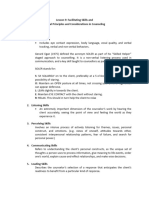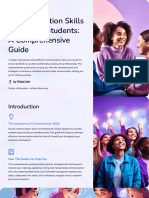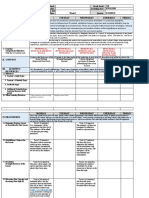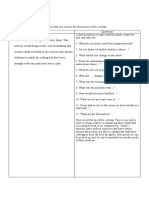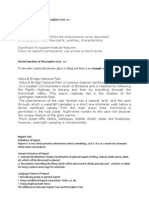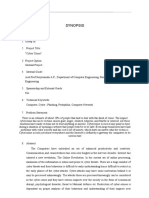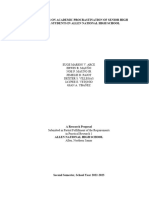Performance Task 4
Performance Task 4
Uploaded by
alvin madahanCopyright:
Available Formats
Performance Task 4
Performance Task 4
Uploaded by
alvin madahanOriginal Description:
Original Title
Copyright
Available Formats
Share this document
Did you find this document useful?
Is this content inappropriate?
Copyright:
Available Formats
Performance Task 4
Performance Task 4
Uploaded by
alvin madahanCopyright:
Available Formats
My Performance Tasks
Performance Task 4
B. Cite the verbal communication strategies that you used in class to support learner understanding,
participation and engagement.
Verbal Communication Strategies Used Cite how it supported the learner’s instructions
Advising others regarding an appropriate
course of action
The best facilitator of learning doesn’t merely tell Assertiveness
Conveying feedback in a constructive manner
their learners what to do and expect them to listen. emphasizing specific, changeable behaviors
Disciplining students in a direct and
Instead, they employ active listening skills to respectful manner
Giving credit to others
understand employee needs and perspectives, Recognizing and countering objections
Showing an interest in others, asking about
engage in verbal negotiation to address and defuse and recognizing their feelings
Speaking calmly even when you’re stressed
issues, and capitalize upon opportunities to praise Terminating staff
Training others to carry out a task or role
individual and achievement. Using affirmative sounds and words like “uh-
huh,” “got you,” “I understand,” “for sure,” “I
see,” and “yes” to demonstrate understanding
Using self-disclosure to encourage sharing
Open and constant lines of communication are Conveying messages concisely
Encouraging reluctant group members to share
vital to students success, particularly when input
Explaining a difficult situation without getting
completing quality- and deadline-critical projects. angry
Explaining that you need assistance
One of the most important skills, strong verbal Paraphrasing to show understanding
Posing probing questions to elicit more detail
communications help to ensure that issues will be about specific issues
Receiving criticism without defensiveness
spotted and resolved in formative stages, averting Refraining from speaking too often or interrupting
others
costly escalation. Requesting feedback
Stating your needs, wants, or feelings without
criticizing or blaming
If a large part of your work involves one-on-one
communications with students, it’s helpful to have Anticipating the concerns of others
Asking for clarification
a “gift of gab” – particularly if you are a sales Asking open-ended questions to stimulate
dialogue
professional. Keep in mind, though, that your Calming an agitated customer by recognizing
and responding to their complaints
conversations need to be focused upon identifying Emphasizing benefits of a product, service, or
proposal to persuade an individual or group
and addressing your student’s needs; using your Noticing non-verbal cues and responding
verbally to verify confusion, defuse anger,
verbal talents to encourage consultative dialogues etc.
will ensure positive student relations.
You might also like
- Don't Starve Together Main Theme (Piano Music Sheet)Document2 pagesDon't Starve Together Main Theme (Piano Music Sheet)Leonid Agarth60% (5)
- Cases of Pronouns-Grade 10Document5 pagesCases of Pronouns-Grade 10Salve Petiluna33% (3)
- 21 Competencies Weebly TableDocument7 pages21 Competencies Weebly Tableapi-425896318No ratings yet
- Verbal Communication Skills List and ExamplesDocument4 pagesVerbal Communication Skills List and ExamplesRamil PastranaNo ratings yet
- Blue and Green Creative Healthy Food Trifold Brochure PDFDocument1 pageBlue and Green Creative Healthy Food Trifold Brochure PDFDalisay BersabalNo ratings yet
- EP Classroom Exercise Dialogue Discussion DebateDocument5 pagesEP Classroom Exercise Dialogue Discussion DebatecvsweetNo ratings yet
- Assessment of Core CompetenciesDocument40 pagesAssessment of Core Competenciesochiengivone05No ratings yet
- Communication Skills An Essential ToolkitDocument7 pagesCommunication Skills An Essential Toolkitsanketdhavale23.diNo ratings yet
- Nest Powerpoint Oracy CH NP GRDocument16 pagesNest Powerpoint Oracy CH NP GRapi-544280724No ratings yet
- Effective Communication Skills For ManagersDocument8 pagesEffective Communication Skills For Managersrockingrahulsinha1No ratings yet
- Public Speaking 01112023 073838amDocument11 pagesPublic Speaking 01112023 073838amumerraza0904No ratings yet
- Principles of PersuasionDocument18 pagesPrinciples of Persuasionengr_rpcurbano100% (1)
- Purposive CommunicationDocument34 pagesPurposive CommunicationRod TempraNo ratings yet
- Enhancing-Life-Skills-for-SuccessDocument10 pagesEnhancing-Life-Skills-for-SuccessDeepika SaxenaNo ratings yet
- SlideEgg - 300443-Public Speaking PresentationDocument19 pagesSlideEgg - 300443-Public Speaking PresentationPJ LunasNo ratings yet
- Umbrella Goals 2Document4 pagesUmbrella Goals 2api-696560926No ratings yet
- Mastering Communication Skills For SuccessDocument10 pagesMastering Communication Skills For SuccessyounesmortadhaNo ratings yet
- GD PPT FinalDocument10 pagesGD PPT FinalsanchitkhannakNo ratings yet
- Wa0000.Document17 pagesWa0000.Shivya GoswamiNo ratings yet
- Listening (Theory)Document37 pagesListening (Theory)Sahar AzharNo ratings yet
- Module 2 HUMSS 11Document9 pagesModule 2 HUMSS 11Laurence Anthony Mercado100% (1)
- Handling-Difficult-Conversations-with-Clients (1)Document9 pagesHandling-Difficult-Conversations-with-Clients (1)khizeraftab1018No ratings yet
- Diass 3 Module NewDocument9 pagesDiass 3 Module Newsheridan dimaanoNo ratings yet
- Diass Handout 2Document3 pagesDiass Handout 2Charlene Mae GraciasNo ratings yet
- CustomerRelation Reviewer3 04Document11 pagesCustomerRelation Reviewer3 04Julius MuicoNo ratings yet
- Introduction To Interpersonal SkillsDocument14 pagesIntroduction To Interpersonal SkillsMoHamed ImRanNo ratings yet
- Chapter 2 Discipline of CounselingDocument6 pagesChapter 2 Discipline of Counselingryanzeta19No ratings yet
- Core & Functional CompentenciesDocument36 pagesCore & Functional CompentenciesKhaled AbozeedNo ratings yet
- Performancereview Ebook Managerresources PDFDocument3 pagesPerformancereview Ebook Managerresources PDFDanielNo ratings yet
- Facilitating Skills and Ethical ConsiderationsDocument6 pagesFacilitating Skills and Ethical ConsiderationsCatherine M. VidalNo ratings yet
- Managerial Skill DevelopmentDocument15 pagesManagerial Skill Developmenttanu kumawatNo ratings yet
- Interpersonal SkillsDocument11 pagesInterpersonal Skillshooribrahim2100No ratings yet
- Assessment of Core competencies-Age-BasedDocument66 pagesAssessment of Core competencies-Age-Basedd cNo ratings yet
- The Discipline of Counseling: Welcome!Document13 pagesThe Discipline of Counseling: Welcome!Sha CalsesNo ratings yet
- Soft Skills PP SaqibDocument16 pagesSoft Skills PP Saqibsamishoaib33No ratings yet
- Group DiscussionDocument15 pagesGroup Discussionhasnainali8220No ratings yet
- Communication: Farah Aliya Fadhila Thariq Ahmad GDocument10 pagesCommunication: Farah Aliya Fadhila Thariq Ahmad Gfarah aliyaNo ratings yet
- Leading The Conversation Unveiling The Communication Styles of Inspiring LeadersDocument2 pagesLeading The Conversation Unveiling The Communication Styles of Inspiring Leaderskedarnath0046No ratings yet
- Revision Principles of ManagementDocument4 pagesRevision Principles of Management22003427No ratings yet
- Effective Communication Skills For School Students A Comprehensive GuideDocument22 pagesEffective Communication Skills For School Students A Comprehensive Guidetisha.parekhNo ratings yet
- Introduction To Interpersonal SkillsDocument14 pagesIntroduction To Interpersonal SkillsMoHamed ImRanNo ratings yet
- Dale Carnegie CourseDocument1 pageDale Carnegie CourseMuhammad AhmadNo ratings yet
- Teaching StrategyDocument13 pagesTeaching Strategyfaisalshakeelmalik525No ratings yet
- Listening SkillsDocument10 pagesListening SkillsSRSNo ratings yet
- sas7Document7 pagessas7diyb.crawford.swuNo ratings yet
- Ese LabDocument8 pagesEse Labvarun765567No ratings yet
- Communication For Various PurposesDocument10 pagesCommunication For Various Purposeshenryace0122No ratings yet
- Diass CounselingDocument7 pagesDiass Counselingkrismaeee15No ratings yet
- Business CommunicationDocument4 pagesBusiness CommunicationmariahdenisseNo ratings yet
- Week 1 - InstructionsDocument11 pagesWeek 1 - InstructionsOmar NagyNo ratings yet
- 2. The-Importance-of-Effective-Communication-in-the-WorkplaceDocument10 pages2. The-Importance-of-Effective-Communication-in-the-Workplacedzaki2028No ratings yet
- Lesson 12 Developing and Delivering A Persuasive SpeechDocument3 pagesLesson 12 Developing and Delivering A Persuasive SpeechDania Nicole Sotelo Baldovino100% (1)
- SocsciedoneDocument4 pagesSocsciedonerosela fainaNo ratings yet
- Barriers to communication are factors that hinder the effective exchange of messages between peopleDocument2 pagesBarriers to communication are factors that hinder the effective exchange of messages between peopleritiksaini7486No ratings yet
- Week 10 Activity 1 &3Document6 pagesWeek 10 Activity 1 &3Myhen Grace QuebecNo ratings yet
- JD - Customer Service & Retention OfficerDocument5 pagesJD - Customer Service & Retention OfficerEkeoma VivianNo ratings yet
- Activity1 - DA - Swot AnalysisDocument3 pagesActivity1 - DA - Swot Analysiszemenemisganew5No ratings yet
- CHAPTER 2 Discipline of Counseling LESSON 1 Counseling Lesson 2 Professionals and Practitioners in CounselingDocument16 pagesCHAPTER 2 Discipline of Counseling LESSON 1 Counseling Lesson 2 Professionals and Practitioners in CounselingErika GeneralNo ratings yet
- In Person CC DialogueDocument3 pagesIn Person CC Dialogueraj bizNo ratings yet
- Psychometric FrameworksDocument19 pagesPsychometric Frameworkssushil.tripathiNo ratings yet
- Emotional Intelligence Mindful ListeningDocument10 pagesEmotional Intelligence Mindful ListeningEnzamamul HaqueNo ratings yet
- Effective Public Speaking: A Practical Guide for Confident CommunicationFrom EverandEffective Public Speaking: A Practical Guide for Confident CommunicationNo ratings yet
- Smaw CoDocument10 pagesSmaw Coalvin madahanNo ratings yet
- Math All QuarterDocument324 pagesMath All Quarteralvin madahanNo ratings yet
- Prob Stat Exam 3rd QuarterDocument3 pagesProb Stat Exam 3rd Quarteralvin madahan100% (1)
- 3rd Quarter Exam For SMAWDocument3 pages3rd Quarter Exam For SMAWalvin madahan100% (1)
- Week 2Document6 pagesWeek 2alvin madahanNo ratings yet
- Week 3Document6 pagesWeek 3alvin madahanNo ratings yet
- Week 1Document6 pagesWeek 1alvin madahanNo ratings yet
- Performance Task 2Document1 pagePerformance Task 2alvin madahanNo ratings yet
- Performance Task 1Document1 pagePerformance Task 1alvin madahanNo ratings yet
- Features of Prose Detailed Lesson PlanDocument15 pagesFeatures of Prose Detailed Lesson Planalvin madahanNo ratings yet
- Eye Gaze: Facial ExpressionsDocument1 pageEye Gaze: Facial Expressionsalvin madahanNo ratings yet
- Performance Task 2Document1 pagePerformance Task 2alvin madahanNo ratings yet
- Performance Task 3: Learning SupportDocument1 pagePerformance Task 3: Learning Supportalvin madahanNo ratings yet
- PT #4Document2 pagesPT #4alvin madahanNo ratings yet
- GET SMART BEFORE YOU START. - Culture and PeopleDocument18 pagesGET SMART BEFORE YOU START. - Culture and PeopleNAHIKARI PANIAGUA ANITUANo ratings yet
- Lord Meher Online (Third Edition: With Corrections) Part 1: 1894 - August 1931Document798 pagesLord Meher Online (Third Edition: With Corrections) Part 1: 1894 - August 1931Srinivasarao PVNo ratings yet
- YsealDocument4 pagesYsealMuhammad Reza Agung SadewaNo ratings yet
- Wonderware Abcip Daserver User'S Guide: Invensys Systems, IncDocument228 pagesWonderware Abcip Daserver User'S Guide: Invensys Systems, Inchatrongtuan1987No ratings yet
- Wayne Shorter ExcerptDocument1 pageWayne Shorter ExcerptcemNo ratings yet
- Final The Effects of Covid-19 On The Working Environment of Workers in Department StoresDocument58 pagesFinal The Effects of Covid-19 On The Working Environment of Workers in Department StoresJoan MonteroNo ratings yet
- Dead SilenceDocument3 pagesDead SilenceNur Nabila Natasya RazifNo ratings yet
- 18.06.100 Jurnal Eproc PDFDocument13 pages18.06.100 Jurnal Eproc PDFAgathaReginaNo ratings yet
- Generic Structure of Descriptive Text AreDocument2 pagesGeneric Structure of Descriptive Text AreSyaiful IpunkNo ratings yet
- Electrical MotorDocument3 pagesElectrical MotorPrakashPrakashNo ratings yet
- The History of User Experience: Citation NeededDocument1 pageThe History of User Experience: Citation NeededAlex MNo ratings yet
- Transpose, Replicate, Blank Commands and AutosumDocument56 pagesTranspose, Replicate, Blank Commands and AutosumRowenn Ronnel OsorioNo ratings yet
- Calibration of Air MeterDocument2 pagesCalibration of Air Meterraja qammarNo ratings yet
- CvSU WFH OJT Performance EvaluationDocument4 pagesCvSU WFH OJT Performance EvaluationMark SamartinoNo ratings yet
- Format of Merger AgreementDocument3 pagesFormat of Merger AgreementLILIANA VALENTINA VACA ARRIAGANo ratings yet
- Alverstoke Junior School Year 4 HomeworkDocument5 pagesAlverstoke Junior School Year 4 Homeworkbzsbeqzod100% (1)
- ShopBot Specsheet 5axisDocument2 pagesShopBot Specsheet 5axisolaolaolaola123No ratings yet
- Gen Math PretestDocument2 pagesGen Math PretestBernardAbulocNo ratings yet
- LE Language Q1 Wk5 v2Document21 pagesLE Language Q1 Wk5 v2SEVERINA ACCADNo ratings yet
- AP Spanish Literature and CultureSummer Work 2017Document8 pagesAP Spanish Literature and CultureSummer Work 2017juneNo ratings yet
- Micom P341 Final Settings PDFDocument10 pagesMicom P341 Final Settings PDFsupermannonNo ratings yet
- Chapter - 5 Do You Believe in Magic? Ritual, Superstition and Why We BuyDocument3 pagesChapter - 5 Do You Believe in Magic? Ritual, Superstition and Why We BuyJigar PatelNo ratings yet
- Daiga Grantina's "Legal Beast Language" - Art AgendaDocument3 pagesDaiga Grantina's "Legal Beast Language" - Art AgendaStarastenkoNo ratings yet
- Cyber Crime SynopsisDocument3 pagesCyber Crime SynopsisKajal ShelarNo ratings yet
- LP in AstronomyDocument7 pagesLP in Astronomyarmand rodriguezNo ratings yet
- HUMSS PRACTICAL RESEARCH PRDocument37 pagesHUMSS PRACTICAL RESEARCH PRyuanaaerith13No ratings yet
- Environment Analysis and Steps in Environment ScanningDocument16 pagesEnvironment Analysis and Steps in Environment Scanningaarzoo dadwalNo ratings yet
- Public Assessment Report Scientific DiscussionDocument8 pagesPublic Assessment Report Scientific Discussionlhthang1990No ratings yet





























